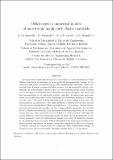| dc.contributor.author | Ní Annaidh, Aisling | |
| dc.contributor.author | Destrade, Michel | |
| dc.contributor.author | Gilchrist, M. | |
| dc.contributor.author | Murphy, J.G. | |
| dc.date.accessioned | 2016-03-02T13:44:39Z | |
| dc.date.available | 2016-03-02T13:44:39Z | |
| dc.date.issued | 2013-08 | |
| dc.identifier.citation | Annaidh, AN,Destrade, M,Gilchrist, MD,Murphy, JG (2013) 'Deficiencies in numerical models of anisotropic nonlinearly elastic materials'. Biomechanics And Modeling In Mechanobiology, 12 :781-791. | en_IE |
| dc.identifier.issn | 1617-7940 | |
| dc.identifier.uri | http://hdl.handle.net/10379/5588 | |
| dc.description.abstract | Incompressible nonlinearly hyperelastic materials are rarely simulated in finite element numerical experiments as being perfectly incompressible because of the numerical difficulties associated with globally satisfying this constraint. Most commercial finite element packages therefore assume that the material is slightly compressible. It is then further assumed that the corresponding strain-energy function can be decomposed additively into volumetric and deviatoric parts. We show that this decomposition is not physically realistic, especially for anisotropic materials, which are of particular interest for simulating the mechanical response of biological soft tissue. The most striking illustration of the shortcoming is that with this decomposition, an anisotropic cube under hydrostatic tension deforms into another cube instead of a hexahedron with non-parallel faces. Furthermore, commercial numerical codes require the specification of a 'compressibility parameter' (or 'penalty factor'), which arises naturally from the flawed additive decomposition of the strain-energy function. This parameter is often linked to a 'bulk modulus', although this notion makes no sense for anisotropic solids; we show that it is essentially an arbitrary parameter and that infinitesimal changes to it result in significant changes in the predicted stress response. This is illustrated with numerical simulations for biaxial tension experiments of arteries, where the magnitude of the stress response is found to change by several orders of magnitude when infinitesimal changes in 'Poisson's ratio' close to the perfect incompressibility limit of 1/2 are made. | en_IE |
| dc.format | application/pdf | en_IE |
| dc.language.iso | en | en_IE |
| dc.publisher | Springer | en_IE |
| dc.relation.ispartof | Biomechanics And Modeling In Mechanobiology | en |
| dc.rights | Attribution-NonCommercial-NoDerivs 3.0 Ireland | |
| dc.rights.uri | https://creativecommons.org/licenses/by-nc-nd/3.0/ie/ | |
| dc.subject | Nonlinear soft tissues | en_IE |
| dc.subject | Anisotropy | en_IE |
| dc.subject | Additive decomposition | en_IE |
| dc.subject | Finite element simulations | en_IE |
| dc.subject | Arterial wall | en_IE |
| dc.subject | Finite elasticity | en_IE |
| dc.subject | Compressibility | en_IE |
| dc.subject | Rubber | en_IE |
| dc.subject | Mechanics | en_IE |
| dc.subject | Skin | en_IE |
| dc.title | Deficiencies in numerical models of anisotropic nonlinearly elastic materials | en_IE |
| dc.type | Article | en_IE |
| dc.date.updated | 2015-10-09T08:20:33Z | |
| dc.identifier.doi | 10.1007/s10237-012-0442-3 | |
| dc.local.publishedsource | http://link.springer.com/article/10.1007%2Fs10237-012-0442-3#page-1 | en_IE |
| dc.description.peer-reviewed | peer-reviewed | |
| dc.contributor.funder | |~| | |
| dc.internal.rssid | 4881053 | |
| dc.local.contact | Michel Destrade, Room Adb-1002, Áras De Brun, School Of Mathematics, Nui Galway. 2344 Email: michel.destrade@nuigalway.ie | |
| dc.local.copyrightchecked | No | |
| dc.local.version | PUBLISHED | |
| nui.item.downloads | 446 | |


